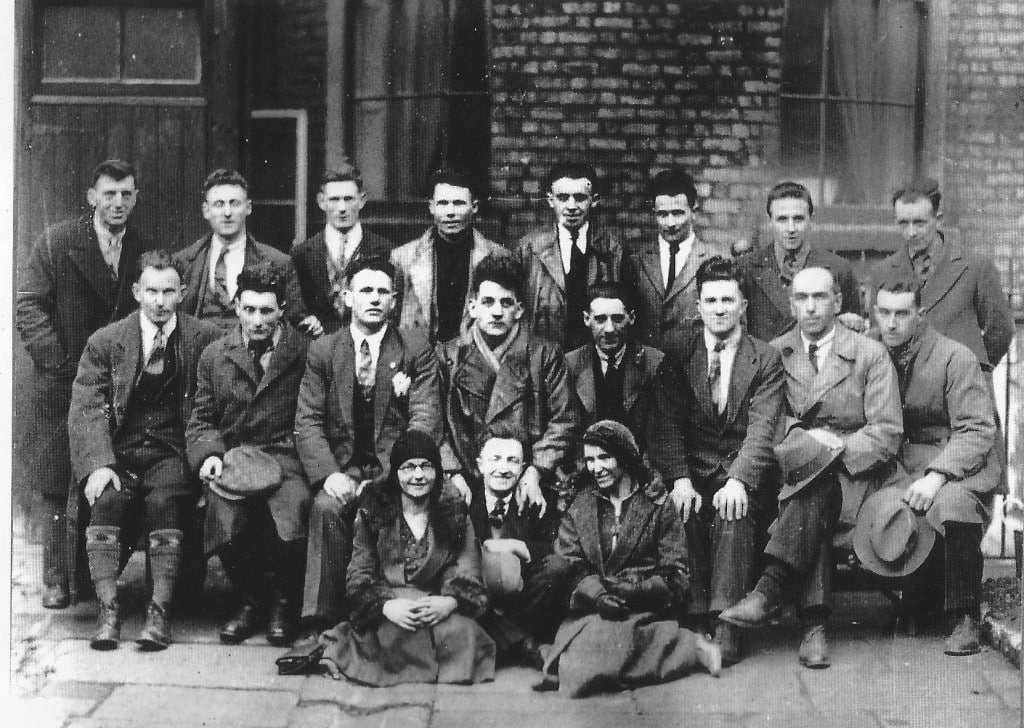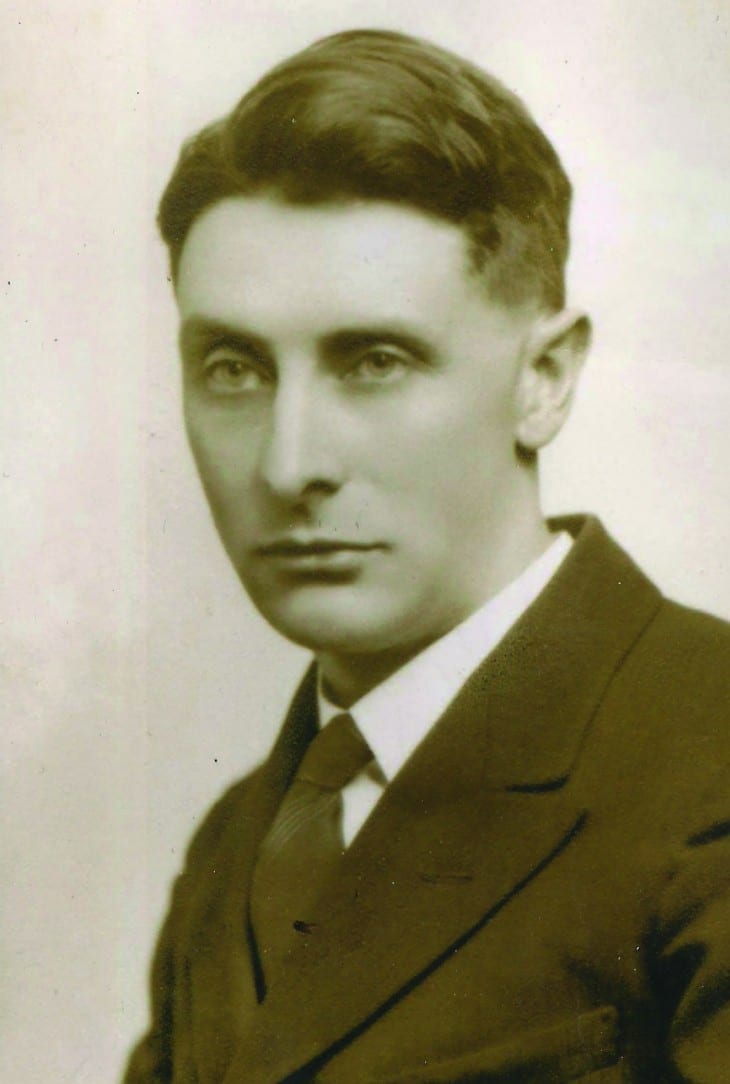By Anthony Coughlan
George Gilmore (1898-1985), whom I knew during the last 20 years of his life, was one of the most remarkable people I ever met.
The Gilmore brothers, George, Charlie and Harry, fought in the War of Independence and the Civil War. They were unusual in being Protestant Republicans. They grew up in Howth where their mother’s people came from. Their paternal grandfather was land-steward to the Blacker family of Carrickblacker Castle near Portadown. The Blackers helped found the Orange Order in 1795. As children the Gilmores had the run of Carrickblacker while the resident Blacker was away. He told me the castle armoury still had weapons and uniforms of Grattan’s volunteers of 1782.
George Gilmore’s first political action was to take down a British Army recruiting poster outside Amiens Street station in 1914. It showed a German soldier bayoneting a civilian against a background of burning churches. Its slogan was: “Join the Army and help defend Catholic Belgium”. He brought it up to Portadown where he pasted it up beside posters with a different appeal: “Join the Army and help defeat Catholic Austria”. It was an early lesson in Britain’s use of religious sectarianism in Ireland.
His father was a prosperous accountant, but was so evangelically religious that he would not let his sons have either secondary or third-level education. Instead they joined the Fianna and the Irish Volunteers. Their unit obeyed MacNeill’s countermanding order in the Easter Rising, but George made a one-man contribution to it. Towards the end of the week British soldiers were gathered on the railway bridge over the road at Clontarf, preparing to enter the city. The Gilmores lived nearby. In the early morning George took his father’s hunting rifle and shot at them from behind a tree. The soldiers scattered. His father said at breakfast that there had been some shooting down the road, but he had heard no one was injured. George said he was much relieved at hearing that.
Following the Rising his father sent George to Carrickblacker for a year to keep him out of trouble. He got to know several local Protestant farmers who had family memories of 1798. “We are the real Republicans”, one of them said to him. It strengthened his view that Protestant-Catholic unity was the basis of any meaningful Irish Republicanism.
A motorbike accident at the start of the Civil War prevented George Gilmore joining the Four Courts republicans. He believed that De Valera, acting through Oscar Traynor, was responsible for preventing IRA reinforcements coming into the city from Blessington to relieve the Four Courts. This was the only step that might have given that conflict a different outcome, he said, for most of the Dublin IRA was then anti-Treaty. “After that it would have been better if we all had gone home instead of continuing the war”.
During the Civil War the Gilmores were active in the South County Dublin area – mainly trenching roads to impede Provisional Government troop movements. George was arrested several times and escaped twice from prison. In 1925 he organised a famous prison-break from Mountjoy. He and two colleagues dressed as policemen pretended to be delivering some new prisoners to the jail. They took over a whole section and succeeded in springing 19 Republican prisoners who got clean away.
Before De Valera founded Fianna Fáil in 1926 George Gilmore was for a while secretary to Sean Lemass. The IRA sent him to Russia to negotiate training facilities, but the British Government learned about it, so the Russians could not help, but instead gave him a tour of the USSR.

“De Valera took the best Republicans with him into Fianna Fail”, Peadar O’Donnell used to say, “and left us with the clinkers”. Gilmore and O’Donnell were close colleagues from the early 1920s. O’Donnell was extrovert, ebullient, the eternal optimist as he launched one political or literary scheme after another. Gilmore was introvert, inclined to political pessimism, the embodiment of austere Protestant integrity. Their politics were those of James Connolly and Liam Mellows. They were socialist Republicans and sought to push the IRA , which in the late 1920s and early 1930s had several thousand members, to the left.
In 1934 when O’Donnell and Gilmore failed to get majority support on the IRA Army Council, they left the IRA and set up the Republican Congress. They envisaged this as a rallying point for leftwing Republicans, trade unions, tenant leagues and the Communist Party, which would push the new Fianna Fáil Government into a more Republican and anti-imperialist direction. George went to America to raise money for it.
Gilmore often recalled the group of Protestant workers from Belfast’s Shankill Road who joined the Republican Congress contingent at the annual commemoration at Wolfe Tone’s grave at Bodenstown in 1934. They marched behind a banner saying “Break the connection with capitalism”. Sadly, they were set upon by the IRA which wanted only their own people to march.
When the Republican Congress petered out after a couple of years Gilmore brought the information they had gathered on Dublin’s appalling slums to Frank Gallagher, then editor of the Irish Press. The articles on slum landlordism which Gallagher carried encouraged the Government to start the first schemes of mass slum clearance and Council house-building. George thought that was one positive legacy of the Republican Congress.
George met Cora Hughes when she got involved in tenant-league agitation for the Congress. She was the great romance of his life. Her father, Frank Hughes, was an old friend of De Valera’s. Cora was Dev’s god-daughter and he too was very fond of her. She had a degree in Celtic Studies from UCD, where she became friends with the poet Charlie Donnelly, who was killed in Spain. She later transferred her affections to the older George.
Once when she was arrested, De Valera, then Taoiseach, sent her books in prison. George believed it was her work in the Dublin slums that gave her the TB that eventually killed her. Cora’s mother and sister did not approve of George as Cora’s fiancé. His politics were opposed to the family idol, De Valera. He was a Protestant, a “Red” and had no proper job.
When Cora Hughes contracted TB the family solution was to send her to Lourdes. Her ultra-pietistic mother said that she would be happy if all her children preceded her to Heaven so that they would be there to greet her when she got there herself! George went to see his political opponent De Valera in the Taoiseach’s office to ask him to use his influence with the family to get Cora to a sanatorium in Switzerland. He recalled De Valera weighing up the options carefully, showing some reluctance to intervene. “You have your rights as her fiancé. I have my rights as her godfather. Her parents have their rights as she is their daughter”, he went on in his methodical way. “And has Cora herself no rights?”, the exasperated Gilmore burst out.
De Valera did get her a visa to go through France in September 1939 as World War 2 broke out, but it was too late. Dev helped carry the coffin at her funeral in Kiltimagh, while his policemen scoured the countryside to ensure no IRA firing party turned up. George stayed away. He never married. He wrote the political-personal story of his romance in fictionalised form as a play, ‘The Gold Flag’. “It would be a theatre smasher”, Denis Johnston said. “Yes, they would smash the theatre alright”, his wife responded, thinking of the political sensitivities of the time. It has never been performed.
In his later decades he did clerical work for Irish Cement Ltd. He supported progressive causes, wrote political pamphlets and was a regular letter-writer to the Irish Times. The Provisional IRA’s long war made him despair, as he saw it further sundering Northern Catholics and Protestants. He lived in a two-room stone cottage near the quarry above the cliff walk in Howth. It had no gas, electricity or running water, but no one else lived nearby and one could see the Mourne Mountains from it. When I visited there last summer I was glad to see a roof being put back on it.
In 1985 when he was aged 87 the bad leg which resulted from his youthful motorbike accident acted up and he was taken to a nearby nursing home in Howth. He could have lived a few years longer but he more or less willed himself to die. He effectively went on hunger strike, refusing food and taking only water. “Take all lovely things away”, he said, pointing to a bowl of roses in the room. I was with him when he died and he made me his literary executor. He is buried in St Fintan’s cemetery, Sutton.
An American scholar, Rosalie Popick, who met him in the National Museum in the last year of his life, is currently writing his biography. He deserves a good one. •
Anthony Coughlan is Associate Professor emeritus of Social Policy at Trinity College Dublin
